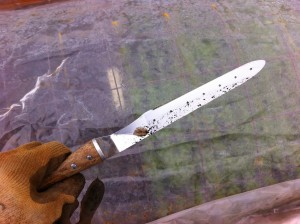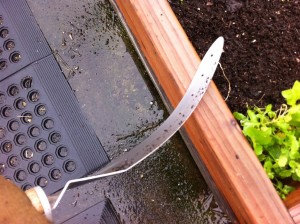Here’s a tool that saves me time. In fact it makes dealing with post-harvest crop residue a breeze. For want of an official name, I call it the stainless steel, flexi-knife.
Given that we grow our greens nice and thick at the Rot, it’s also a given that we get a nice mat of stemmy residue after a cutting or two.
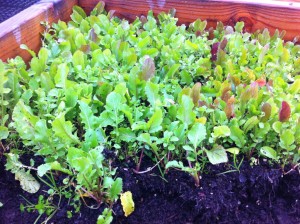 |
| Although this arugula may appear to be still useable, the red color of some of the leaves reveals its status as a worn out patch of greens. Quick, time for the flexi-knife! |
I could spend a lot of time hacking all this greenery back into the soil, and clearly there would be a benefit in that. As the stems and root systems decomposed, all those stored nutrients would be liberated back from whence they came to nourish another round of growth, BUT all that takes time, and while waiting I’d have a messy bed which would impede a quick-turnaround reseeding. And since in a small garden bed downtime is a no-no, I searched for another route. As we all know, behind every great new technique or process, there is usually a great tool.
For solving my quick-turnover problem my thanks go out to the crafty Japanese, who seem able to produce the most exceptional garden tools, from exquisitely balanced hand hoes to the brutishly effective Hori-Hori weeding knife. Here’s yet another feather in their caps, this flexi-, stainless steel weeding knife, which probably has a wonderful, evocative Japanese name that, unfortunately, I don’t know. It’s basically a gardener’s analog to the Japanese cabinet-makers’ saws which have the same extraordinary flexibility.
On first glance it doesn’t look that special – maybe a cheap, TV bread knife with smaller-than-average serrations. But just put a little pressure on it and – whoa – the genius is revealed. It bends!
This remarkable bendability in the blade allows the gardener to slice just beneath the root zone of a carpet of greens, effectively creating a sod of whatever crop one might wish.
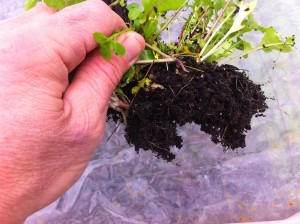
While this could lead to a new industry of instant arugula and mustard lawns, my goal is not to dig up healthy plants for relocation elsewhere. I prefer to use it to remove spent plants en masse. I send these tops and roots to the roof’s “stomach” (more on that in a later post) to be composted, and what remains is a fairly clean bed of undersoil. Then it’s just a dash or two of fertilizer on top of this, well scratched in, and a light application of fresh compost. Minutes after looking at a completely carpeted bed of spent greens, I’m ready to seed again into fresh, black, clean earth. It’s almost like watching one of those cooking shows where the chef goes from raw ingredients to finished products in minutes, except this time it’s the garden not the kitchen (obviously) and there’s no staff making all the magic happen…the tool makes the magic happen.
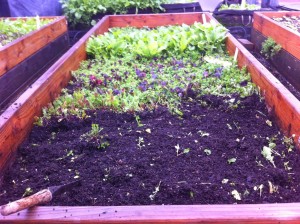 |
| Greens awaiting harvest in the back; spent green stems in the middle, and flexi-knife prepped section in the front. With a little fertilizer and fresh compost, that cleared section is ready for re-planting immediately. |
Yes, there are many other tools I could use to the same purpose, but the ease and elegance of the flexi-knife convinces me that it’s the perfect tool for the job and, as such, causes yet another case of tool drool! Now the unfortunate part. I found this tool at my local specialty nursery, and a quick google search has yet to turn up other examples of it, much less it’s proper name. So while I have perhaps enticed you to want this tool for your gardening, I cannot lead you to where you can get it. A cruel blow, I know, which I will try to remedy with a more in-depth search. At the very least I’m going to haul back to the nursery and check the shelves to see if they still have the tool in stock and what it’s called. Otherwise I would be like Pavlov, initiating a salivary response (the tool drool) with just some artificial stimulus (words) and never actually providing the salivary-worthy goods (the tool itself).


